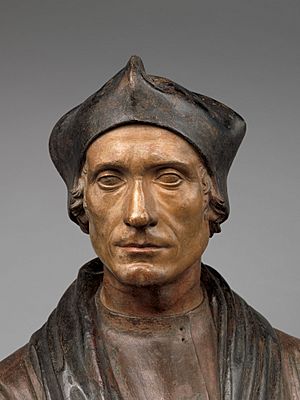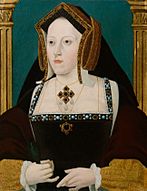Richard Roose facts for kids

Richard Roose was a man accused of a serious crime in 1531. He was said to have poisoned people in the home of John Fisher, who was the Bishop of Rochester. Because of this accusation, Richard Roose was put to death. We don't know much about Roose himself, not even his real name. He might have been a cook for Bishop Fisher, or perhaps a friend of the cook, at Fisher's house in Lambeth, England.
Roose was accused of putting a white powder into porridge that was served to Bishop Fisher's guests and servants. This porridge was also given to poor people as an act of kindness. Sadly, two people died from eating the poisoned food: Burnet Curwen, who worked for Fisher, and a poor woman named Alice Tryppyt. Roose said that a stranger had given him the powder and that he thought it was just a joke. Bishop Fisher was lucky; he didn't eat anything that day, so he survived. Roose was arrested soon after.
King Henry VIII was very worried about poisoning, and he spoke to the English Parliament about the case. He likely helped create a new law that made poisoning a very serious crime, almost like treason (betraying your country or king). This law was even made to apply to Roose's actions, even though they happened before the law was passed. Richard Roose was executed in April 1532 in Smithfield, a place in London.
Contents
Why Bishop Fisher Was a Target
Bishop Fisher was not popular with King Henry VIII. The King wanted to end his marriage to Katherine of Aragon so he could marry Anne Boleyn. The Church, however, did not allow this. Bishop Fisher strongly supported Katherine and spoke out against Anne Boleyn.
Rumors and Other Attacks
Because of Fisher's strong opinions, some people at the time whispered that Anne Boleyn or her father, Thomas, Earl of Wiltshire, might have been behind the poisoning at Fisher's house. It was not clear if the King knew about this. There was even another attempt to harm Fisher. A cannon was fired towards his home from the direction of Thomas Boleyn's house in London. No one was hurt, but the roof of Fisher's house was badly damaged. These attacks, and Roose's execution, seemed to make Fisher leave London. This was good for the King's plans.
What Happened Next
Bishop Fisher was later put to death in 1535. This was because he opposed new laws called the Acts of Supremacy. These laws made the English monarch (the King or Queen) the head of the Church of England, instead of the Pope. King Henry VIII eventually separated from the Catholic Church and married Anne Boleyn.
The Poisoning Law
The special law against poisoning that Henry VIII created did not last long. His son, Edward VI, removed it almost immediately after Henry died. However, the case of Richard Roose continued to be remembered by people. It was even mentioned in legal discussions for many years after. Historians often see Roose's execution as an important moment in legal history. It showed how the King could use laws to deal with his political and religious enemies.
Images for kids
-
Roose's place of execution: Smithfield, as shown on the Agas map of 1561





